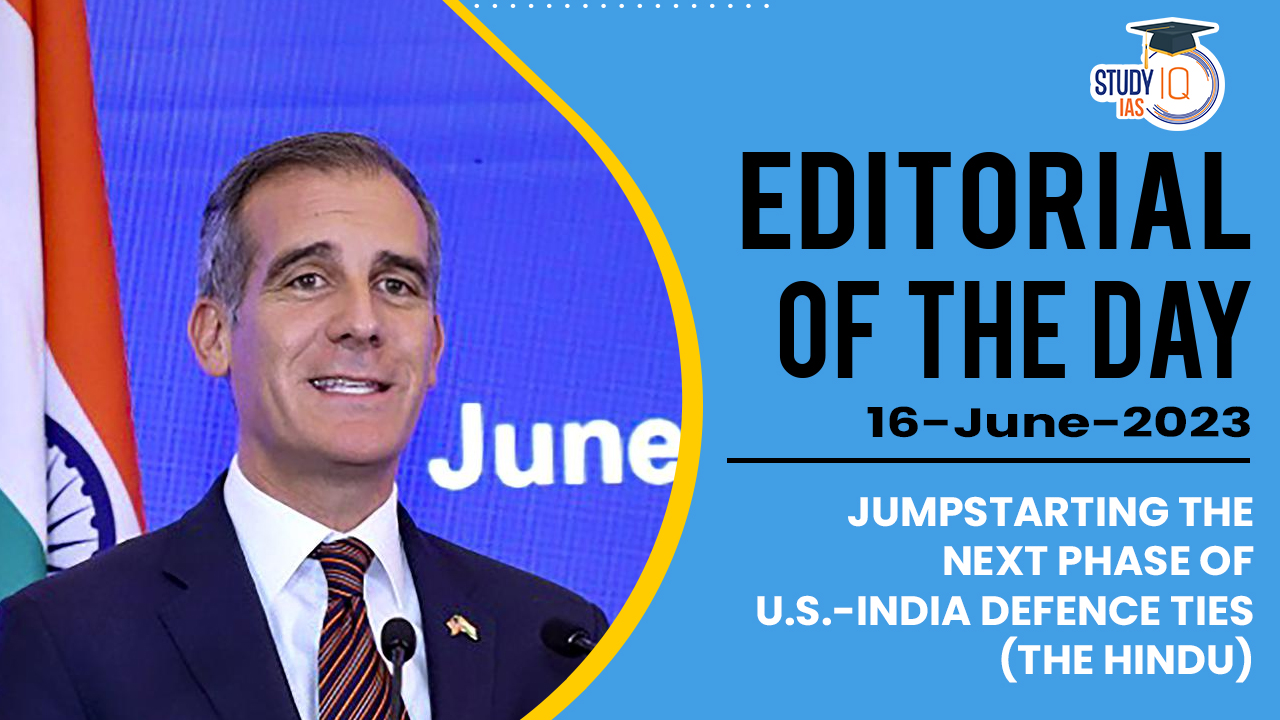Table of Contents
Context: The article is discussing the recent visit of the US Secretary of Defence to India and its significance in strengthening the U.S.-India defence relationship. The visit aimed to bolster the major defence partnership between the two countries and advance cooperation in critical areas. During the visit, an agreement on a road map for defence industrial cooperation was secured, which is part of the U.S.-India initiative on Critical and Emerging Technology (iCET) agreement. The article highlights how this move has the potential to reposition the United States within the broader context of the U.S.-India strategic relationship. It also mentions the “Major Defense Partner” status of India, along with the four foundational agreements signed with the United States. Overall, the article highlights the growing momentum in U.S.-India ties, primarily driven by the defence relationship, and the efforts to deepen cooperation in defence technology and manufacturing.
Background
Evolution of India-US Relations:
The relationship between India and the United States has evolved significantly over the years.
- During the Cold War, India pursued a non-aligned foreign policy and maintained a distance from both the US and the Soviet Union.
- However, in the early 1990s, India began to open up its markets to foreign investment, including from the US, and undertook significant economic reforms. This led to a gradual improvement in relations between the two countries.
- The two countries have also increased their defence ties, with the US becoming India’s second-largest arms supplier after Russia.
- In recent years, India’s growing strategic importance as a counterweight to China has led to closer ties with the US, particularly in the security and defence domains.
- The US and India have also cooperated on climate change, with both countries announcing ambitious targets to reduce greenhouse gas emissions.
Overall, the relationship between India and the US has moved from a period of estrangement to a strategic partnership based on shared interests and values. While there have been occasional bumps in the road, both countries are committed to deepening their ties in the years to come.
Decoding the Editorial
The article is discussing the growing ties between India and the US.
- Growing Momentum in India-US ties:
- In recent years, there has been significant progress and positive momentum in the bilateral relationship between the United States and India, with the defence sector playing a crucial role in driving this momentum.
- Recently, an agreement on a road map for defence industrial cooperation was achieved.
- This agreement is part of the U.S.-India initiative on Critical and Emerging Technology (iCET) announced in May 2022.
- The road map aims to boost defence manufacturing in India by fostering greater technological cooperation between the two countries.
- The objectives of the agreement align with India’s own mission of self-reliance and reducing its dependence on defence imports.
- Additionally, the agreement signifies the increasing importance of the United States as a partner in India’s defence and technology sectors, further strengthening the overall strategic relationship between the two countries.
- Objectives of the recent Visit: The objectives of the visit by the United States Secretary of Defence to India revolved around two key areas: technological innovation and growing military cooperation.
- Additionally, during the visit, a new initiative called Indus-X was launched.
- This initiative is designed to provide a fresh impetus to defence innovation engagement between the United States and India.
- It builds upon the U.S.-India bilateral Space Situational Awareness arrangement, which was signed in 2022.
- The Space Situational Awareness arrangement focuses on enhancing information-sharing and cooperation in the space sector between the two countries.
- The launch of Indus-X further extends this cooperation and aims to drive innovation in the defence domain.
- “Major Defense Partner” (MDP) status:
- The article highlights the significance of India’s “Major Defense Partner” (MDP) status and the four foundational agreements signed with the United States.
- These developments have important implications for the sharing of technology and promoting more frequent cooperation between the two countries.
- The MDP status granted to India, along with the foundational agreements, enables the sharing of sensitive defence technologies between the United States and India.
- This sharing of technology is notable because it does not require India to become a formal ally of the United States.
- US-India Defence Partnership W.R.T the Indo-Pacific:
- The Defence Secretary described the U.S.-India defence partnership as the cornerstone of their engagement in the Indo-Pacific.
- This indicates that the defence cooperation between the two countries plays a crucial role in their strategic approach to the Indo-Pacific region.
- Several broad aspects of the Indo-Pacific were discussed during the dialogue such as coercive actions by China, Russia’s aggressive actions towards Ukraine, transnational issues like terrorism and climate change. These aspects serve as challenges and concerns in the region.
- The combined threat assessments by India and the U.S. indicate that China is seen as a common and prominent challenge in the region.
- The article mentions the China Military Power Report 2022 published by the U.S., which highlights the People’s Liberation Army Navy (PLA Navy) as the world’s largest navy in terms of the number of ships. This suggests that China’s naval capabilities and presence are significant factors in the Indo-Pacific.
- It also suggests that with the Indo-Pacific region becoming more contested, it is expected that China’s subsurface presence, particularly in the Indian and Pacific Oceans, will likely increase.
- This indicates that China’s naval activities and submarine capabilities are expected to have a growing impact on the strategic dynamics of the region.
- Rationale for promoting broader industrial cooperation:
- Broader Industrial cooperation between Indian and U.S. companies in the defense sector emphasizes the scale of American investments in India and the support of the U.S. government for India’s defense modernization efforts.
- The existing American investments in India provide a strong basis for expanding industrial cooperation between Indian and U.S. companies in the defence sector.
- American companies, such as Boeing, Lockheed Martin, BAE Systems, Honeywell Aerospace, Raytheon, and Textron, have already partnered with Indian companies like Hindustan Aeronautics Limited and the Tata group for defence manufacturing.
- The U.S. government has expressed clear support for its companies to contribute to India’s defence modernization, creating a conducive environment for collaboration.
- In the long run, three dominant trends that could emerge from U.S.-India defence cooperation.
- Firstly, there would be the nurturing and growth of an ecosystem of joint ventures between companies from both countries. This implies that collaborative partnerships would be established, allowing for the pooling of resources and expertise to pursue defence-related projects.
- Secondly, the United States could gradually gain a larger share in the Indian defence manufacturing sector. This implies an increasing involvement of American companies in manufacturing activities related to defence in India, potentially leading to technology transfers and knowledge sharing.
- Thirdly, both sides would work towards overcoming existing impediments in co-development and co-production. This indicates a mutual effort to address any challenges or barriers that hinder effective collaboration in joint defence projects.
- Furthermore, the “innovation bridge” announced in the iCET agreement aims to connect defence start-ups from both countries. This suggests that the collaboration would extend beyond established companies to include innovative start-ups in the defence industry.
- Defence Technology and Trade Initiative (DTTI):
- The DTTI has faced criticism for being overly ambitious and encountering challenges related to bureaucratic resistance, sensitive technology transfer, and differences in the defence ecosystems of India and the United States.
- However, recent developments indicate a renewed effort to revitalise the DTTI and give it specific momentum in terms of co-production and co-development in the defence sector.
- The iCET agreement has provided a boost to the DTTI and set the stage for further advancements in defence cooperation between India and the United States.


 Daily Quiz 14 April 2025
Daily Quiz 14 April 2025
 UPSC Syllabus 2025, Check UPSC CSE Sylla...
UPSC Syllabus 2025, Check UPSC CSE Sylla...
 EU Plans to Slash General Data Protectio...
EU Plans to Slash General Data Protectio...





















